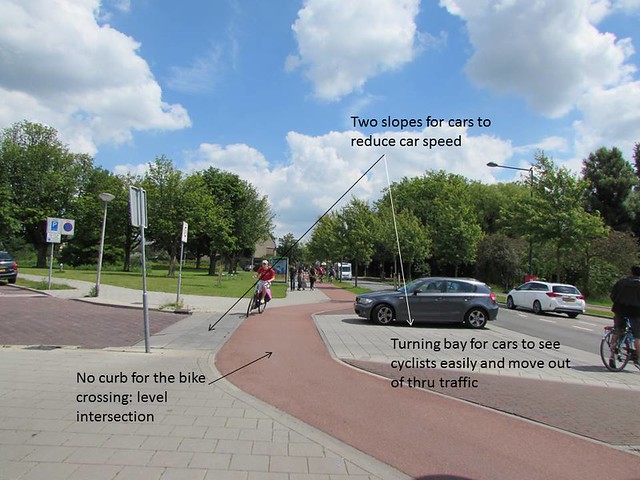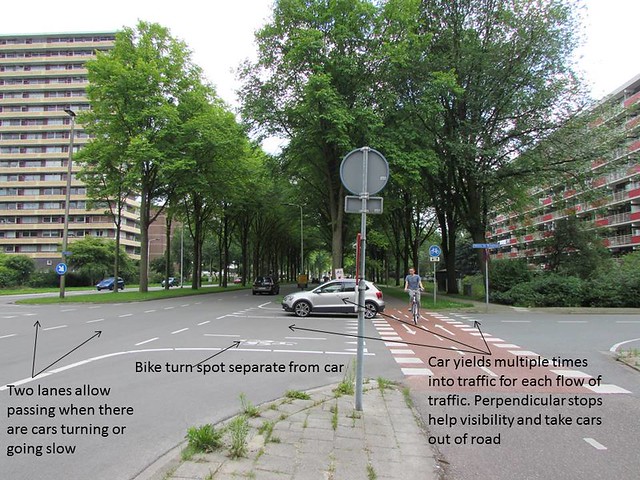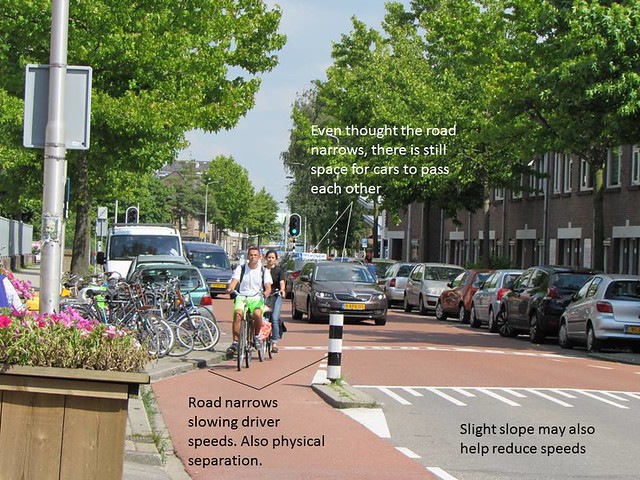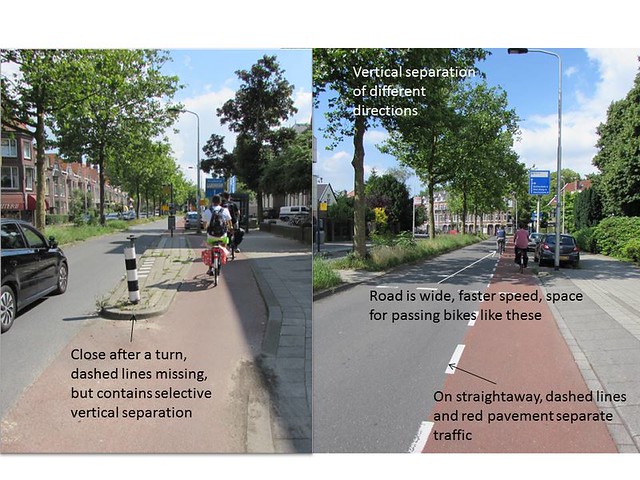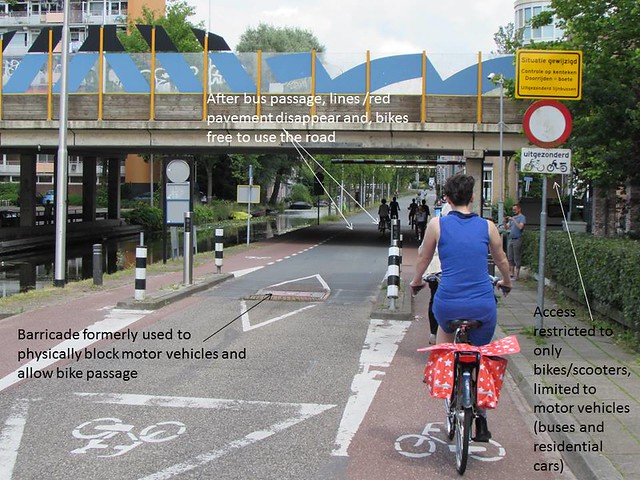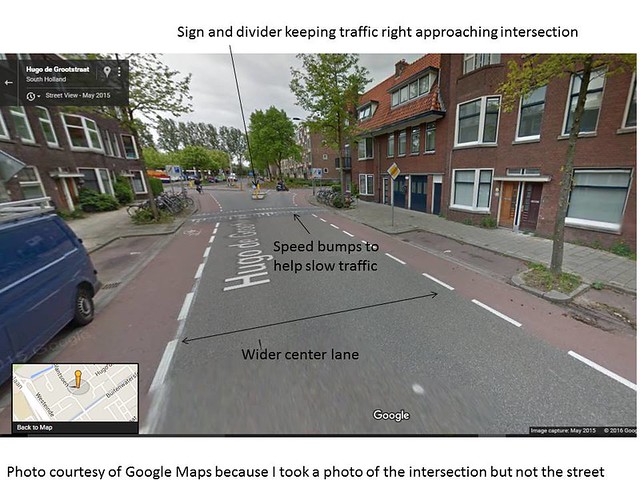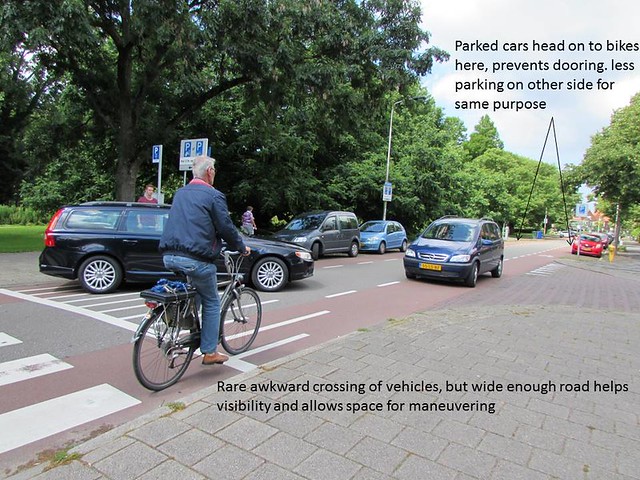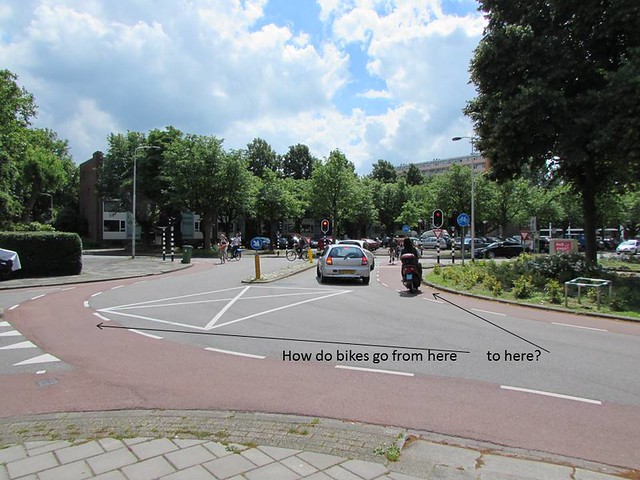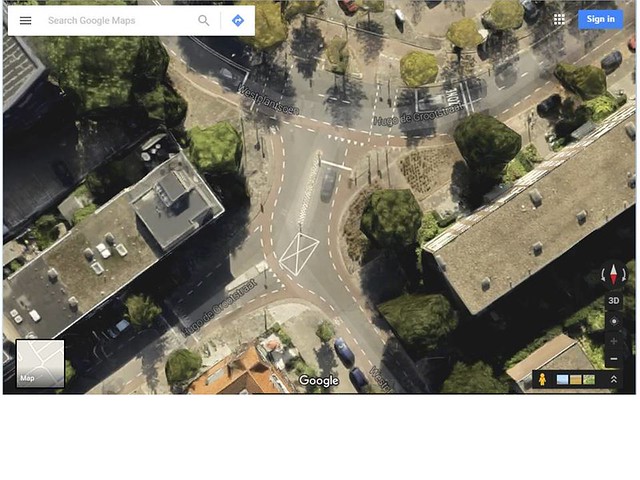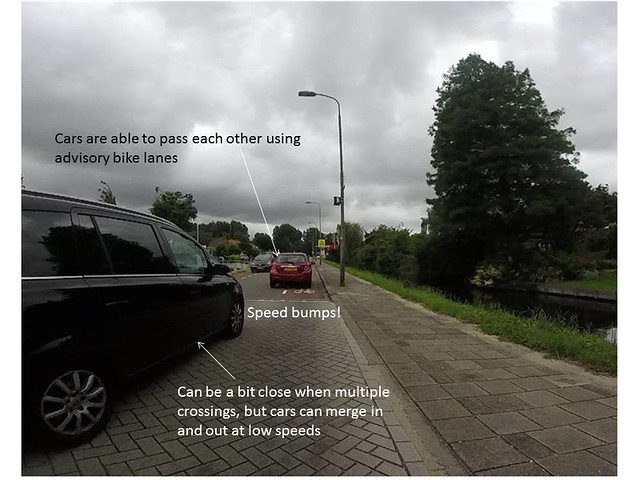Cycle Tracks:
These bike facilities are also called protected bike lanes, because they are exclusive bikeways that have some sort of vertical divider between bicycle traffic and road traffic. These dividers are vertical, and often come in the form of raised medians with grass or trees. They are usually between parking lanes and sidewalks.
The first cycle track we visited was Ruys de Beerenbrouckstraat, where, like the other cycle tracks we visited, was separated by vertical features (trees, curbs, and greenspace). Here, the traffic was also reduced to one lane, further reducing the amount of traffic stress. On this road in particular, it seems that there were a lot of connecting roads, and occasions where a car may cross the bike path to access a side road. These crossings were made safer for both cars and cyclists by creating a raised crossing, indented from the road.
This way, the car feels less stress from turning in a one lane road by moving out of thru traffic, and the car is able to see the oncoming bike traffic. This same type of intersection is also featured on Voorhofdreef, where bold dashed lines bring attention to the cycle track crossings.
Cyclists feel much safer on such intersections because cars are forced to go slower on the intersection, and forced to see the cyclists. For me anyways, the fact that the car feels more relaxed in the turn (no rush to get out of one lane road), I feel much more comfortable crossing the street as a priority vehicle because there is no pressure on me to rush across the street. The only stress I would feel at a spot like this is if multiple cars were turning, and began to block the road.
Another featured cycle track was at Papsouwselaan, where the road was converted from a 2+2 primarily car road, with tram rails in the middle, to a 1+1 car road, plus cycle tracks and wider sidewalks. Of course, this transformation increased riders and pedestrians to use this road by making this a slower area. From the center of the tram rail going out, speeds are decreasing, which makes sense. Bikes alongside a tram would be frightening, because trams are large, and although they may not be fast, it is less likely that they would see a cyclist on the side, and be able to stop. Cars parallel to cycle tracks is typical, but once again, the car lane is made more bike-friendly by removing passing lanes, and reducing speed. The major mind blowing reconstruction of this street is the removal of the major intersection. By replacing traffic lights with a series of yield signs, the reduced car flow (one lane) does not build up, and people go when they feel it is safe
Intersections like this make everyone more aware of their surroundings, and it seems that bikers and drivers are all moving slow enough that both are willing to stop for each other if either a bike wants to cross the street quickly or suddenly or if cyclists want to wait on the designated space to let cars by. This kind of reconstruction seems to take a lot of resources. But in reality, it is just a reconfiguration of the right car lane (to a cycle track and a wider sidewalk), as well as the replacement of traffic lights to yield signs, which may actually cost less to maintain. The higher cost may come from creating a faster thruway for the reduced intersection. But it makes a lot more sense to put passing cars on a faster thruway than congesting cars on a more crowded shopping street, making everyone unhappy.
Bike Lanes
Bike lanes are not vertically separated from road traffic. They are usually marked with painted lines and colored asphalt, and located between parked cars and moving car traffic.
Bike lanes don’t feel that stressful, at least compared to the US. On the first road with bike lanes, Nassaulaan, there seemed to be very little traffic. When cars were passing, they were going slow enough that I felt they were aware of the cyclists on either side, and they could stop if needed.
Even at the point where there were no bike lanes painted on the ground, the road narrowed, perhaps forcing cars to move closer to bikes, but more importantly, slowing them down, giving it still a safer feel than even marked lanes could get in Boston. It also turned to red pavement (like bike lanes), which I imagine makes it register more as a bike priority road.
It was clear though on Julianalaan and Buitenhofdreef I felt compelled to ride faster, with the noises of passing cars surrounding me. In this setting, bike lanes are of course cheap, but they still offer enough reassurance that it doesn’t deter riders from using the road. The car has enough space to go, and the bike has enough space to go. The one way traffic assures that there would be no oncoming traffic pushing the car into the bike lane. Parking spots on the other side mean that cars may cross the bike lanes, but because the job is parking, they need to stop, and in stopping, become aware of passing cyclists, and cyclists and other cars are aware of a standing car in the road. The bike lane even provides enough space for bikes to pass each other.
The only fear was for bikes entering the lane from a side street, or the sidewalk (which doesn’t happen but we did it on this particular tour). Cars aren’t moving particularly slow. If an entering bike wasn’t careful and made a wide turn upon entering the bike lane, they could easily cause tension with a passing driver. If a cyclist was not aware upon entering the lane, other bikes may swerve into car traffic. Fortunately on this road, there were very few cyclists entering the road, except for us, and we were entering from the sidewalk. I suppose this makes it a good road to apply a bike lane. There are few dangerous opportunities in which a bike and a car cross each other’s paths. A bike path or cycle track could be even more welcoming, but even then, the cheaper painted lane didn’t seem to deter users.
One last observation about other lanes was the presence of occasional vertical separation. These were usually place in segments of the road that were changing shape or direction. This small segment of separation was enough to alert the driver to keep space from cyclists that may be changing their movement patterns from a straight line. One noticeable usage of this method was after an intersection This selective protection is cheaper than continuous separation, and helps guide cyclists and drivers in potential trouble spots of the road.
Bike Boulevard:
A bike boulevard is often a historic road that has been demoted from a main street to a road with primarily bicycle traffic. These roads are usually scenic and lead to residential/local streets. There is very limited/restricted motor traffic, and bikes and pedestrians often spread out into the entire length of the street.
The primary example was the Buitenwatersloot. Because there were very few markings on the road it felt like the entire road was mine. But it made me a bit concerned about cars trying to get through. The car would be so quiet I wouldn’t realize it was there. But this more than anything just made me feel guilty for spreading out a little bit on the road. There was no sense of danger on a road like this, as cyclist and pedestrian volumes are high and car volume was extremely low.
This road provided a big modification on a historic main street, by removing car traffic, and only allowing the passage of busses. I may be remembering incorrectly, but it seemed that there were still a few cars on the road, trying to get to houses/local businesses. It feels very safe on a road more or less dedicated to bicycles and pedestrians. There is still risk of collision, of course, but none of these collisions would be deadly. Although it seems like these roads are being simplified, This method of demotion may or may not be pretty pricey on a city, because it forces the city to create an alternate, faster thruway for cars that can no longer use the street. In some cases, this may just mean diverting traffic to a parallel street. Which costs very little, as drivers become trained to taking less direct route (which doesn’t take that much longer in a motorized vehicle). In other cases, a road may need to be built, which would require much more funding to create.
Advisory Lanes:
Advisory lanes are often used on roads that are too narrow to have complete bike lanes or cycle tracks. Here, there is usually a center lane of slow speeds, for car traffic in two directions. When two cars approach each other head on, they move to the right, into the bike advisory lane. Because the road speeds are slow, the cars are able to merge with bike traffic and not cause too much stress for cyclists.
These felt just as safe as bike lanes, perhaps even safer. The main reason for feeling safer is because these advisory lanes occur on streets with two way traffic with no centerline, causing cars to move through very slowly to avoid collisions with oncoming traffic, which was already very little. Oftentimes, such as on Molenweg and Hugo de Grootstraat, there were speed bumps further reducing the speed of the cars.
The only time I saw this causing a problem was when there was a giant truck stopped in the road, on Adriaan Pauwstraat causing a pile up, and some confusion between cars and bikes that were trying to pass each other.
I imagine this was an anomaly, which could be ignored, but trucks do need to make deliveries, and the road didn’t account for a situation like this. And it doesn’t cost any more than applying some paint. The only time I had any confusion due to the markings on the road was for some intersections where I wasn’t able to see where a bike was allowed to turn left. Perhaps some light can be shed on that.
Link to location on map:
https://www.google.nl/maps/@52.0069772,4.3476752,123a,27.6y,180h/data=!3m1!1e3?hl=en
At location 11, even when cars needed to pass each other, they would slow down enough so that they would be at par with a bicycle, meaning they could pass each other by driving essentially with a bike in the advisory lane. I didn’t feel there was any danger to this because they would basically merge into the lane slowly enough that either bikers wouldn’t feel any pressure or they could easily slow down. Also, the advisory lane was put on a straight and open enough road that bikers could easily see oncoming cars.
Bike Highway:
A bike highway resembles a bike path from America. It is a wider path, dedicated to primarily bikes, but also pedestrians. They are very isolated from traffic and often cut through scenic green space, where cars are unable to go. They are routes especially efficient for bikes because of their ability to cut across car inaccessible areas.
We didn’t stop on this road, because we were hungry. But there was also a feeling that we didn’t have to stop, because the path was removed almost completely from road traffic, and there was very little entering bicycle traffic. Because the path was wide and removed, there was the ability to travel at higher speeds. The only time we were really forced to slow was during the underpass, where we went downhill then up again on the other side of the car highway. I would say this makes the bike highway less friendly, but it made sense when we emerged from the other side, because that was where the bike highway ended. The hill up from the underpass slowed us down to meet right with the intersection with the main road in front of the university. Because the bike highway is relatively narrow, just removed from traffic, it would be relatively easy to install in open spaces, unless the space was privately owned. The path is user friendly because it is isolated, and cuts through spaces that cars would have to circumnavigate.

